Copyright The New York Times

The world’s leading energy agency is backing away, sort of, from its view that global demand for fossil fuels could very well peak by the end of the decade. Two years ago, the International Energy Agency caused a stir when it published a widely read analysis suggesting that the world’s use of oil, gas and coal could start to decline by the 2030s because of the energy policies many governments were pursuing. The prospect that fossil fuel demand might soon peak was seen as a potential turning point in efforts to slow climate change. But in a major new report published on Wednesday, the energy agency has a different message about a peak in fossil fuel use: It’s complicated. The agency’s latest World Energy Outlook, a comprehensive report on global energy trends, still includes its previous “stated policies” scenario, essentially projecting that countries will continue enacting policies that help tackle climate change and adopting solar panels, wind turbines and electric vehicles at a rapid clip, potentially leading to a decline or plateau in the use of oil, gas and coal by 2035. The report’s authors say that neither scenario should be considered a definitive prediction about the future. Instead, the scenarios are intended to allow politicians to see the consequences of different policy choices. “There can be no single or simple view on how the global energy outlook might develop,” the authors wrote. The energy agency’s reports are highly influential and often cited by governments and investors as a basis for long-term planning. But its forecasts have also come under tremendous political scrutiny in recent years, particularly from the oil and gas industry. Critics of the I.E.A. say the agency has been underestimating future demand for fossil fuels as emerging economies in Africa, Latin America and Asia become richer. OPEC, the oil cartel, has warned that prematurely predicting a peak in oil and gas use could lead companies to underinvest in the drilling of new wells. Then, if demand for fossil fuels remained strong, the lack of supply could lead to “energy chaos,” OPEC has said. Mr. Wright had lobbied the energy agency to bring back its current policies scenario, which the agency had jettisoned in 2020. That scenario assumes that countries will not adopt any new policies, such as stricter fuel-efficiency standards for cars, beyond those that they have already finalized. It also typically shows a brighter future for oil and gas. In an essay posted online, the authors of this year’s report said they were restoring the current policies scenario because it was appropriate to consider multiple possibilities for the way the future might unfold. They did not say they were responding to pressure from the United States. “Every year, we carefully review the scenarios included” in the report “to make sure they remain as useful and relevant as possible to policymakers and other stakeholders,” they wrote. “This year is no different.” Other analysts said that higher projections of future fossil-fuel demand failed to fully account for the rapid decline in the price of solar panels and batteries. Many emerging economies like Brazil and India are turning to wind and solar power, lured by cheap equipment from China. Electric cars are proliferating in unexpected places, like Nepal and Ethiopia. “There’s a revolution happening right now and it’s in renewables and electrification,” said Dave Jones, chief analyst at Ember, a London-based energy research organization. “Scenarios based on policies and legislation are behind the curve of technology change.” In all of its scenarios, the I.E.A. sees renewable power growing strongly, and coal-fired power declining over the next decade. But the pace of change matters: Under its current policies scenario, the agency assumes that countries have a tougher time incorporating the fluctuating power from wind and solar farms into their electric grids, and so have to burn more gas and coal. The report also notes that demand for electricity is now rising faster than expected around the world. While some of that is a result of tech companies in places like the United States that are now investing more than $500 billion annually in data centers for artificial intelligence, a much bigger driver is the rapidly growing demand for appliances, heating and cooling in developing countries. Many nations are also facing new threats to their energy security, the agency warned. China dominates the refining of many key minerals used in batteries, for instance. And while the world currently has more than enough affordable oil and gas to satisfy any near-term demand, unexpected conflicts or swings in demand could cause major price spikes. “When we look at the history of the energy world in recent decades, there is no other time when energy security tensions have applied to so many fuels and technologies at once,” said Fatih Birol, the agency’s executive director. Under the stated policies scenario, the world is expected to warm roughly 2.5 degrees Celsius, or 4.5 degrees Fahrenheit, this century compared with preindustrial levels. But under the current policies scenario, where oil and gas demand keeps rising for decades, global warming reaches 2.9 degrees Celsius by 2100 and then keeps climbing. While that difference may sound minor, scientists have found that an extra half-degree of warming brings significantly greater risks from heat waves, floods, drought and species extinction. (The world has already warmed roughly 1.3 degrees since preindustrial times.) Two years ago, at a climate summit in Dubai in the United Arab Emirates, virtually every world leader agreed that nations should begin “transitioning away” from fossil fuels in order to lower the risks of global warming. But at this year’s summit in Belém, Brazil, nations are still struggling to figure out what exactly that promise means and how quickly they should move. “That agreement was to transition away in a ‘just, equitable and orderly manner,’” said Ana Toni, the Brazilian chief executive of this year’s climate summit, known as COP30. “So what counts as just, equitable and orderly?” She noted, for instance, that some countries still rely heavily on revenues from fossil fuel production. “There are some very complex issues.” The I.E.A. report also notes that nations are still lagging on another front: Ensuring that everyone has access to basic energy services. Roughly 730 million people still lack access to electricity, and an additional 2 billion rely on polluting and unhealthy cooking methods like burning wood or dung indoors.



